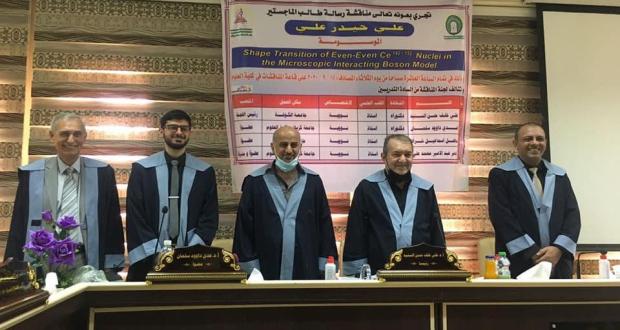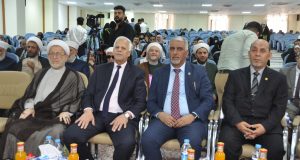The Faculty of Science at Kerbala University has discussed the M.A. Thesis entitled ” The pair-to-pair (142-152 Ce) cerium nucleation shape transition by the microscopic interacting boson model”
The thesis, presented by a M.A. student, Ali Haider Ali from the Department of Physics, aims at achieving the theoretical description of the nuclear structure and the quantitative transmission of the even-paired isotopes of cerium (142-152Ce)) using the model of the microscopic interacting bosons through the calculation of energy levels, values of B (E2), values B (M1), mixing ratios of electromagnetic transitions, two-nucleon transmission interactions and surface potential energy (PES). These calculations help to know the final shape of these nuclei
The thesis deals with the scientific methods in conducting a comprehensive descriptive study of the properties of isotopes of cerium (142-152Ce) within the first microscopic interacting boson model (IBM-1). The energy of mass nuclear states has been studied using the PHINT program and the prediction of some energy levels and confirmation of the equivalence of Uberm for some cases, and the energy levels in the range were also predicted by estimating the energy of the second state with a twist and symmetry 2_2 ^ + for 150,152 Ce isotopes.
The thesis discusses ways of computing the reduced transitions of the electric quadrupole B (E2), the reduced transitions probability of the magnetic dipole B (M1), and the electromagnetic mixing ratio and quadrupole moment of the isotopes under study using FBEM code. The moment of inertia has been calculated and the transitional energy of the twine and the rotational frequency are studied and compared with the experimental data, and the transition energy (L → L-2) is plotted as a function of this rotation to determine the presence of the phenomenon of back bending, but these isotopes did not show the phenomenon of back bending in them.
The discussion shows the mechanism of determining the surface of the PES potential energy for these isotopes, and the calculation of the intensity of the neutron transfer reaction to determine the structure of the evolution of Ce isotopes, as it has been noted that the series of isotopes 142-152 Ce suffers a rapid development in its structural properties at n = 88
The thesis concludes that the even-paired isotopes of cerium under study in this work are examples showing a phase transition from the first order from the vibrational form to the rotational form and lined up along the U (5) to SU (3) side of the IBM triangle , the high bending states with the ground beam of 150,152 Ce nuclei produced well under IBM-1 , and the increase in the probability of electrical transfers with an increase in the number of bosons with a decrease in energy levels, and a decrease in the values of the probability of magnetic transfers with an increase in the number of bosons, and PES calculations proved that the prolate shape is more dominant than the oblate shape of these isotopes.

 University of Kerbala
University of Kerbala
































































